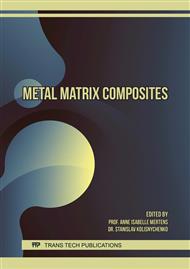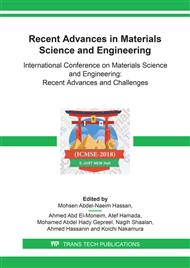[1]
M. Gasik, Functionally graded materials: bulk processing techniques,, Int. J. Mater. Prod. Technol., vol. 39, p.20–29, (2010).
Google Scholar
[2]
A. Gupta and M. Talha, Recent development in modeling and analysis of functionally graded materials and structures,, Prog. Aerosp. Sci., p.1–14, (2015).
Google Scholar
[3]
A. Edwin, V. Anand, and K. Prasanna, Sustainable Development Through Functionally Graded Materials : An Overview,, RASAYAN J. CHEM, vol. 10, no. 1, p.149–152, (2017).
Google Scholar
[4]
Ashwinkumar A kokanee, Review on Functionally Graded Materials and various theories,, Int. Res. J. Eng. Technol., p.890–893, (2017).
Google Scholar
[5]
E. Akinlabi, R. Mahamood, Functionally Graded Materials. Switzerland: Springer International Publishing, (2017).
Google Scholar
[6]
R. Kumar and C. Chandrappa, Synthesis and Characterization of Al-SiC Functionally Graded Material Composites Using Powder Metallurgy Techniques,, Int. J. Innov. Res. Sci. Eng. Technol., vol. 3, no. 8, p.15464–15471, (2014).
DOI: 10.15680/ijirset.2014.0308054
Google Scholar
[7]
F. Erdemir, A. Canakci, and T. Varol, Microstructural characterization and mechanical properties of functionally graded Al2024/SiC composites prepared by powder metallurgy techniques,, Trans. Nonferrous Met. Soc. China, vol. 25, no. 11, p.3569–3577, (2015).
DOI: 10.1016/s1003-6326(15)63996-6
Google Scholar
[8]
P. Muller, P. Mognol, and J. Y. Hascoet, Modeling and control of a direct laser powder deposition process for Functionally Graded Materials (FGM) parts manufacturing,, J. Mater. Process. Technol., vol. 213, no. 5, p.685–692, (2013).
DOI: 10.1016/j.jmatprotec.2012.11.020
Google Scholar
[9]
D. W. Hutmacher, M. Sittinger, and M. V. Risbud, Scaffold-based tissue engineering: Rationale for computer-aided design and solid free-form fabrication systems,, Trends Biotechnol., vol. 22, no. 7, p.354–362, (2004).
DOI: 10.1016/j.tibtech.2004.05.005
Google Scholar
[10]
Z. Pin-wen, H. You-liang, and W. Xin, A Review on Functionally Gradient Materials ( FGMs) and Their Applications,, in Materials Science and Engineering, 2017, vol. 229.
Google Scholar
[11]
Y. Watanabe and H. Sato, Review Fabrication of Functionally Graded Materials under a Centrifugal Force,, in Nanocomposites with Unique Properties and Applications in Medicine and Industry, China: InTech, 2011, p.133–150.
DOI: 10.5772/20988
Google Scholar
[12]
B. Kieback, A. Neubrand, and H. Riedel, Processing techniques for functionally graded materials,, Mater. Sci. Eng. A, vol. 362, p.81–105, (2003).
DOI: 10.1016/s0921-5093(03)00578-1
Google Scholar
[13]
T. P. D. Rajan, R. M. Pillai, and B. C. Pai, Characterization of centrifugal cast functionally graded aluminum-silicon carbide metal matrix composites,, Mater. Charact., vol. 61, no. 10, p.923–928, (2010).
DOI: 10.1016/j.matchar.2010.06.002
Google Scholar
[14]
A. S. Karun, T. P. D. Rajan, U. T. S. Pillai, and B. C. Pai, Enhancement in tribological behaviour of functionally graded SiC reinforced aluminium composites by centrifugal casting,, J. Compos. Mater., (2015).
DOI: 10.1177/0021998315602946
Google Scholar
[15]
E. Jayakumar, J. C. Jacob, T. P. D. Rajan, M. A. Joseph, and B. C. Pai, Processing and Characterization of Functionally Graded Aluminum (A319)-SiCp Metallic Composites by Centrifugal Casting Technique,, Metall. Mater. Trans. A, vol. 47, no. 8, p.4306–4315, (2016).
DOI: 10.1007/s11661-016-3558-8
Google Scholar
[16]
A. Velhinho, J. D. Botas, E. Ariza, J. R. Gomes, and L. A. Rocha, Tribocorrosion Studies in Centrifugally Cast Al-matrix SiCp -reinforced Functionally Graded Composites,, Mater. Sci. Forum, vol. 456, p.871–875, (2004).
DOI: 10.4028/www.scientific.net/msf.455-456.871
Google Scholar
[17]
A. C. Vieira, P. D. Sequeira, J. R. Gomes, and L. A. Rocha, Dry sliding wear of Al alloy/SiCp functionally graded composites : Influence of processing conditions,, Wear, vol. 267, p.585–592, (2009).
DOI: 10.1016/j.wear.2009.01.041
Google Scholar
[18]
E. Jayakumar, T. P. D. Rajan, and B. C. Pai, Processing and Characterization of SiCp Reinforced Functionally Graded AA 6061 Aluminium Metal Matrix Composites,, Adv. Mech. Robot. Eng., vol. 1, no. 2, (2014).
Google Scholar
[19]
K. V. Babu, J. T. W. Jappes, and T. P. D. Rajan, Dry sliding wear studies on SiC reinforced functionally graded aluminium matrix composites,, Jounal Mater. Des. Appl., vol. 230, no. 1, p.182–189, (2014).
DOI: 10.1177/1464420714556665
Google Scholar
[20]
T. R. Prabhu, Processing and properties evaluation of functionally continuous graded 7075 Al alloy/SiC composites,, Arch. Civ. Mech. Eng., vol. 17, no. 1, p.20–31, (2016).
DOI: 10.1016/j.acme.2016.08.004
Google Scholar
[21]
N. Radhika and R. Raghu, Effect of Centrifugal Speed in Abrasive Wear Behavior of Al-Si5Cu3/SiC Functionally Graded Composite Fabricated by Centrifugal Casting,, Trans. Indian Inst. Met., (2017).
DOI: 10.1007/s12666-017-1204-9
Google Scholar
[22]
A. Vidyapeetham and N. Radhika, Optimisation of Dry Sliding Wear Process Parameters for Aluminium Hybrid Metal,, Tribol. Ind., vol. 36, no. 2, (2014).
Google Scholar
[23]
N. Radhika and R. Raghu, Experimental Investigation on Abrasive Wear Behavior of Functionally Graded Aluminum Composite,, J. Tribol., vol. 137, no. July, p.1–7, (2015).
DOI: 10.1115/1.4029941
Google Scholar
[24]
N. Radhika, Analysis of Tribological Behaviour of Functionally Graded LM13 Aluminium/TiS2 Composite Using Design of Experiments,, Tribol. Ind., vol. 38, no. 3, p.425–434, (2016).
Google Scholar
[25]
K. Bhatija and N. Radhika, Studies on sliding wear characteristics of aluminium LM25/silicon dioxide functionally graded composite and optimisation of parameters using response surface methodology,, Mat.-wiss. u. Werkstofftech, vol. 48, p.600–610, (2017).
DOI: 10.1002/mawe.201600560
Google Scholar
[26]
I. M. El-Galy, M. H. , Ahmed, and B. I. Bassiouny, Characterization of functionally graded Al-SiCp metal matrix composites manufactured by centrifugal casting,, Alexandria Eng. J., vol. 56, no. 1, (2017).
DOI: 10.1016/j.aej.2017.03.009
Google Scholar
[27]
W. Kai and S. Wenju, Microstructures in Centrifugal Casting of SiCp/AlSi9Mg Composites with Different Mould Rotation Speeds,, J. Wuhan Univ. Technol. Sci. Ed., vol. 26, no. 3, p.504–509, (2011).
DOI: 10.1007/s11595-011-0257-6
Google Scholar



